Modeling and Optimizing Ultrasound-Assisted Extractions of Pectin and Phenolic Compounds from Coffee Husk Waste Using Response Surface Methodology
Abstract
1. Introduction
2. Materials and Methods
2.1. Material Sample Preparation and Chemicals
2.2. Extraction Conditions
2.3. Chemical Analysis
- Ac = Control absorbance (DPPH 60 µM);
- As = Absorbance of the sample;
- Ab = Absorbance of the blank.
2.4. Chemometric Analysis
2.5. DART Mass Spectrometry of Aqueous Extractions of Dried Husk
2.6. FTIR-ATR Characterization of Pectin of Coffee Husk
2.7. Statistical Analysis
3. Results
3.1. Factors with a Significant Impact on Ultrasound-Assisted Extraction
3.2. Predictive Mathematical Model and Validation for Optimal Extraction Conditions
3.3. FTIR-ATR and DART-MS Analyses
4. Discussion
5. Conclusions
Supplementary Materials
Author Contributions
Funding
Acknowledgments
Conflicts of Interest
References
- Xotlanihua-Flores, D.; Crespo-Stupková, L. Exportaciones del café mexicano a los mercados estadounidense y alemán. Rev. Iberoam. Vitic. Agroind. Ruralidad 2024, 11, 150–169. [Google Scholar] [CrossRef]
- Navajas-Porras, B.; Castillo-Correa, M.; Navarro-Hortal, M.D.; Montalbán-Hernández, C.; Peña-Guzmán, D.; Hinojosa-Nogueira, D.; Romero-Márquez, J.M. The Valorization of Coffee By-Products and Waste Through the Use of Green Extraction Techniques: A Bibliometric Analysis. Appl. Sci. 2025, 15, 1505. [Google Scholar] [CrossRef]
- Maredia, M.; Martínez, J.M. Coffee’s Innovation Crisis: Determining the Size of the Agricultural R&D Investment Gap for Coffee Amid Growing Consumer Demand and the Climate Crisis. World Coffee Research 2023. Available online: https://worldcoffeeresearch.org/resources/coffees-innovation-crisis (accessed on 13 June 2025).
- Poncet, V.; van Asten, P.; Millet, C.P.; Vaast, P.; Allinne, C. Which diversification trajectories make coffee farming more sustainable? Curr. Opin. Environ. Sustain. 2024, 68, 101432. [Google Scholar] [CrossRef]
- International Coffee Organization. Sustainability and Resilience of Global Coffee Value Chain. 2024. Available online: www.icocoffee.org/documents/cy2023-24/report-global-coffee-funding-mechanisms-june-2024-e.pdf (accessed on 13 June 2024).
- Barreto Peixoto, J.A.; Silva, J.F.; Oliveira, M.B.P.P.; Alves, R.C. Sustainability Issues along the Coffee Chain: From the Field to the Cup. Comp. Rev. Food Sci. Food Saf. 2023, 22, 287–332. [Google Scholar] [CrossRef]
- Klingel, T.; Kremer, J.I.; Gottstein, V.; de Rezende, T.R.; Schwarz, S.; Lachenmeier, D.W. A review of coffee by-products including leaf, flower, cherry, husk, silver skin, and spent grounds as novel foods within the European Union. Foods 2020, 9, 665. [Google Scholar] [CrossRef] [PubMed]
- Bondam, A.F.; Diolinda da Silveira, D.; Pozzada dos Santos, J.; Hoffmann, J.F. Phenolic compounds from coffee by-products: Extraction and application in the food and pharmaceutical industries. Trends Food Sci. Technol. 2022, 123, 172–186. [Google Scholar] [CrossRef]
- Kumar, S.S.; Swapna, T.S.; Sabu, A. Coffee Husk: A Potential Agro-Industrial Residue for Bioprocess. In Waste to Wealth. Energy, Environment, and Sustainability; Singhania, R., Agarwal, R., Kumar, R., Sukumaran, R., Eds.; Springer: Singapore, 2018; pp. 97–109. [Google Scholar] [CrossRef]
- Bojórquez-Quintal, E.; Xotlanihua-Flores, D.; Bacchetta, L.; Diretto, G.; Maccioni, O.; Frusciante, S.; Rojas-Abarca, L.M.; Sánchez Rodríguez, E. Bioactive Compounds and Valorization of Coffee By-Products from the Origin: A Circular Economy Model from Local Practices in Zongolica, Mexico. Plants 2024, 13, 2741. [Google Scholar] [CrossRef] [PubMed]
- Usman, M.; Nakagawa, M.; Cheng, S. Emerging Trends in Green Extraction Techniques for Bioactive Natural Products. Processes 2023, 11, 3444. [Google Scholar] [CrossRef]
- Pongsiriyakul, K.; Wongsurakul, P.; Kiatkittipong, W.; Premashthira, A.; Kuldilok, K.; Najdanovic-Visak, V.; Adhikari, S.; Cognet, P.; Kida, T.; Assabumrungrat, S. Upcycling Coffee Waste: Key Industrial Activities for Advancing Circular Economy and Overcoming Commercialization Challenges. Processes 2024, 12, 2851. [Google Scholar] [CrossRef]
- Urias-Orona, V.; Rascón-Chu, A.; Lizardi-Mendoza, J.; Carvajal-Millán, E.; Gardea, A.A.; Ramírez-Wong, B. A Novel Pectin Material: Extraction, Characterization and Gelling Properties. Int. J. Mol. Sci. 2010, 11, 3686–3695. [Google Scholar] [CrossRef]
- Manasa, V.; Padmanabhan, A.; Anu Appaiah, K.A. Utilization of coffee pulp waste for rapid recovery of pectin and polyphenols for sustainable material recycle. Waste Manag. 2021, 120, 762–771. [Google Scholar] [CrossRef]
- Novosel’skaya, I.L.; Voropaeva, N.L.; Semenova, L.N.; Rashidova, S.S. Trends in the science and applications of pectins. Chem. Nat. Comp. 2000, 36, 1–10. [Google Scholar] [CrossRef]
- Biratu, G.; Woldemichael Woldemariam, H.; Girma Gonfa, G. Optimization of pectin yield extracted from coffee Arabica pulp using response surface methodology. Heliyon 2024, 10, e29636. [Google Scholar] [CrossRef] [PubMed]
- Özdemir, M.; Yildirim, R.; Yurttaş, R.; Başargan, D.; Hakci, M.B. A Review of ultrasound-assisted extraction of bioactive compounds from coffee waste. Derleme Gida 2025, 50, 56–73. [Google Scholar] [CrossRef]
- Hu, S.; Gil-Ramírez, A.; Martín-Trueba, M.; Benítez, V.; Aguilera, Y.; Martín-Cabrejas, M.A. Valorization of coffee pulp as bioactive food ingredient by sustainable extraction methodologies. Curr. Res. Food Sci. 2023, 6, 100475. [Google Scholar] [CrossRef] [PubMed]
- Quispe Solano, M.A.; Corilla Flores, D.D.; Chuquilín-Goicochea, R.; Espinoza Silva, C.R.; Camayo Lapa, B.F.; Huamán De La Cruz, A.R.; Manyary Cervantes, G.M. Optimization of ultrasound-assisted extraction of polyphenols from coffee (Coffea arabica L.) shell and pulp using response surface methodology. J. Southwest Jiaotong Univ. 2022, 57, 600–616. [Google Scholar] [CrossRef]
- Analytical Methods Committee AMCTB. Experimental design and optimisation (4): Plackett–Burman designs. Anal. Methods 2013, 5, 1901–1903. [Google Scholar] [CrossRef] [PubMed]
- López-Mercado, J.; Nambo, A.; Toribio-Nava, M.E.; Melgoza-Sevilla, O.; Cázarez-Barragán, L.; Cajero-Zul, L.; Guerrero-Ramírez, L.-G.; Handy, B.E.; Cardenas-Galindo, M.-G. High and low esterification degree pectins decomposition by hydrolysis and modified Maillard reactions for furfural production. Clean. Technol. Environ. Policy 2018, 20, 1413–1422. [Google Scholar] [CrossRef]
- Singleton, V.L.; Orthofer, R.; Lamuela-Raventós, R.M. Analysis of total phenols and other oxidation substrates and antioxi-dants by means of Folin-Ciocalteu reagent. Methods Enzymol. 1999, 299, 152–178. [Google Scholar] [CrossRef]
- Blois, M. Antioxidant Determinations by the Use of a Stable Free Radical. Nature 1958, 181, 1199–1200. [Google Scholar] [CrossRef]
- Bacchetta, L.; Canditelli, M.; Platamone, G.; Procacci, S.; Di Palma, P.R.; Maccioni, O.; Montereali, M.R.; Alisi, C.; Forni, C. Use of cactus pear pruning waste to improve soil properties and to produce high-quality compost. Org. Agr. 2024, 14, 263–275. [Google Scholar] [CrossRef]
- Wang, Y.; Liu, L.; Ma, L.; Liu, S. Identification of saccharides by using direct analysis in real time (DART) mass spectrometry. Int. J. Mass Spectrom. 2014, 357, 51–57. [Google Scholar] [CrossRef]
- Procacci, S.; Bojórquez-Quintal, E.; Platamone, G.; Maccioni, O.; Lo Vecchio, V.; Morreale, V.; Alisi, C. Opuntia ficus-indica Pruning Waste Recycling: Recovery and Characterization of Mucilage from Cladodes. Nat. Resour. 2021, 12, 91–107. Available online: https://www.scirp.org/html/2-2001000_108538.htm (accessed on 20 April 2021). [CrossRef]
- Zouambia, Y.; Ettoumi, K.Y.; Krea, M.; Moulai-Mostefa, N. A new approach for pectin extraction: Electromagnetic induction heating. Arab. J. Chem. 2017, 10, 480–487. [Google Scholar] [CrossRef]
- Kozioł, A.; Sroda-Pomianek, K.; Górniak, A.; Wikiera, A.; Cyprych, K.; Malik, M. Structural Determination of Pectins by Spectroscopy Methods. Coatings 2022, 12, 546. [Google Scholar] [CrossRef]
- Lira-Ortiz, A.L.; Reséndiz-Vega, F.; Ríos-Leal, E.; Contreras-Esquivel, J.C.; Chavarría-Hernández, N.; Vargas-Torres, A.; Rodríguez-Hernández, A.I. Pectins from waste of prickly pear fruits (Opuntia albicarpa Scheinvar ‘Reyna’): Chemical and rheological properties. Food Hydrocoll. 2014, 37, 93–99. [Google Scholar] [CrossRef]
- Choudhary, D.K.; Chaturvedi, N.; Singh, A.; Mishra, A. Characterization, inhibitory activity and mechanism of polyphenols from faba bean (gallic-acid and catechin) on a-glucosidase: Insights from molecular docking and simulation study. Prep. Biochem. Biotechnol. 2019, 50, 123–132. [Google Scholar] [CrossRef]
- Carreira-Casais, A.; Carpena, M.; Pereira, A.G.; Chamorro, F.; Soria-Lopez, A.; Perez, P.G.; Otero, P.; Cao, H.; Xiao, J.; Simal-Gandara, J.; et al. Critical variables influencing the ultrasound-assisted extraction of bioactive compounds—A review. Chem. Proc. 2021, 5, 50. [Google Scholar] [CrossRef]
- Beaudor, M.; Vauchel, P.; Pradal, D.; Aljawish, A.; Phalip, V. Comparing the efficiency of extracting antioxidant polyphenols from spent coffee grounds using an innovative ultrasound assisted extraction equipment versus conventional method. Chem. Eng. Process 2023, 188, 109358. [Google Scholar] [CrossRef]
- Hoseini, M.; Cocco, S.; Casucci, C.; Cardelli, V.; Corti, G. Coffee by-products derived resources—A review. Biomass Bioenergy 2021, 148, 106009. [Google Scholar] [CrossRef]
- Li, Z.; Zhou, B.; Zheng, T.; Zhao, C.; Gao, Y.; Wu, W.; Fan, Y.; Wang, X.; Qiu, M.; Fan, J. Structural characteristics, rheological properties, and antioxidant and anti-glycosylation activities of pectin polysaccharides from Arabica coffee husks. Foods 2023, 12, 423. [Google Scholar] [CrossRef] [PubMed]
- Garcia, R.; Arriola, D.; de Arriola, M.C.; de Porres, E.; Rolz, C. Characterization of coffee pectin. LWT Food Sci. Technol. 1991, 129, 125–129. [Google Scholar]
- Reichembach, L.H.; de Oliveira Petkowicz, C.L. Extraction and characterization of a pectin from coffee (Coffea arabica L.) pulp with gelling properties. Carbohydr. Polym. 2020, 245, 116473. [Google Scholar] [CrossRef]
- Vallejos-Jiménez, A.; Cadena-Chamorro, E.M.; Santa, J.F.; Buitrago-Sierra, R.; Dugmore, T.I.J.; Bose, S.; Matharu, A.S. Development of novel pectin-based films from coffee waste: Mucilage and pulp. Waste Biomass Valori 2025, 16, 1–16. [Google Scholar] [CrossRef]
- Chandel, V.; Biswas, D.; Roy, S.; Vaidya, D.; Verma, A.; Gupta, A. Current advancements in pectin: Extraction, properties and multifunctional applications. Foods 2022, 11, 2683. [Google Scholar] [CrossRef] [PubMed]
- Kumar, K.; Srivastav, S.; Sharanagat, V.S. Ultrasound assisted extraction (UAE) of bioactive compounds from fruit and vegetable processing by-products: A review. Ultrason. Sonochem 2021, 70, 105325. [Google Scholar] [CrossRef]
- Singh, N.; Yadav, S.S. A review on health benefits of phenolics derived from dietary spices. Curr. Res. Food Sci. 2022, 5, 1508–1523. [Google Scholar] [CrossRef]
- Hammann, W.; Ross, A.; Seames, W. Sequential extraction of carbohydrates and lipids from Chlorella vulgaris using combined physical and chemical pretreatments. Chem. Eng. 2024, 8, 11. [Google Scholar] [CrossRef]
- Tran, T.M.K.; Akanbi, T.; Kirkman, T.; Nguyen, M.H.; Vuong, Q.V. Optimal aqueous extraction conditions as a green technique for recovery of phenolic antioxidants from Robusta dried coffee pulp. Eur. J. Eng. Technol. Res. 2020, 5, 1069–1074. [Google Scholar] [CrossRef]
- Maran, J.P.; Priya, B.; Al-Dhabi, N.A.; Ponmurugan, K.; Moorthy, I.G.; Sivarajasekar, N. Ultrasound assisted citric acid mediated pectin extraction from industrial waste of Musa balbisiana. Ultrason. Sonochem 2017, 35, 204–209. [Google Scholar] [CrossRef]
- Serrat-Díaz, M.; De la Fé-Isaac, Á.D.; De la Fé-Isaac, J.A.; Montero-Cabrales, C. Extracción y caracterización de pectina de pulpa de café de la variedad Robusta. Rev. Cuba. Química 2018, 30, 522–538. [Google Scholar]
- Bacchetta, L.; Maccioni, O.; Martina, V.; Bojorquez-Quintal, E.; Persia, F.; Procacci, S.; Zaza, F. Quality by design approach to optimize cladodes soluble fiber processing extraction in Opuntia ficus indica (L.) Miller. J. Food Sci. Technol. 2019, 56, 3627–3634. [Google Scholar] [CrossRef] [PubMed]
- Tibbits, C.W.; MacDougall, A.J.; Ring, S.G. Calcium binding and swelling behaviour of a high methoxyl pectin gel. Carbohydr. Res. 1998, 310, 101–107. [Google Scholar] [CrossRef]
- Flutto, L. determination. In Encyclopedia of Food Sciences and Nutrition, 2nd ed.; Caballero, B., Ed.; Academic Press: San Diego, CA, USA, 2003; pp. 4440–4449. [Google Scholar]
- Rebollo-Hernanz, M.; Cañas, S.; Taladrid, D.; Benítez, V.; Bartolomé, B.; Aguilera, Y.; Martín-Cabrejas, M.A. Revalorization of coffee husk: Modelling and optimizing the green sustainable extraction of phenolic compounds. Foods 2021, 10, 653. [Google Scholar] [CrossRef] [PubMed]
- Lestari, W.; Hasballah, K.; Listiawan, M.Y.; Sofia, S. Coffee by-products as the source of antioxidants: A systematic review. F1000Research 2022, 11, 220. [Google Scholar] [CrossRef]
- Mourtzinos, I.; Menexis, N.; Iakovidis, D.; Makris, D.P.; Goula, A. A Green extraction process to recover polyphenols from byproducts of hemp oil processing. Recycling 2018, 3, 15. [Google Scholar] [CrossRef]
- Wang, L.; Zhou, Y.; Wang, Y.; Qin, Y.; Liu, B.; Bai, M. Two green approaches for extraction of dihydromyricetin from chinese vine tea using β-cyclodextrin-based and ionic liquid-based ultrasonic-assisted extraction methods. Food Bioprod. Process 2019, 116, 1–9. [Google Scholar] [CrossRef]
- Loukri, A.; Tsitlakidou, P.; Goula, A.; Assimopoulou, A.N.; Kontogiannopoulos, K.N.; Mourtzinos, I. Green extracts from coffee pulp and their application in the development of innovative brews. Appl. Sci. 2020, 10, 6982. [Google Scholar] [CrossRef]
- Nardini, M.; Cirillo, E.; Natella, F.; Mencarelli, D.; Comisso, A.; Scaccini, C. Detection of bound phenolic acids: Prevention by ascorbic acid and ethylenediaminetetraacetic acid of degradation of phenolic acids during alkaline hydrolysis. Food Chem. 2002, 79, 119–124. [Google Scholar] [CrossRef]
- Peng, S.; Zou, L.; Zhou, W.; Liu, W.; Liu, C.; McClements, D.J. Encapsulation of lipophilic polyphenols into nanoliposomes using pH-driven method: Advantages and disadvantages. J. Agric. Food Chem. 2019, 67, 7506–7511. [Google Scholar] [CrossRef]
- Spiegel, M.; Cel, K.; Sroka, Z. The mechanistic insights into the role of pH and solvent on antiradical and prooxidant properties of polyphenols—Nine compounds case study. Food Chem. 2023, 407, 134677. [Google Scholar] [CrossRef] [PubMed]
- Tran, T.M.K.; Akanbi, T.; Kirkman, T.; Nguyen, M.; Vuong, Q.V. Maximising recovery of bioactive compounds from coffee pulp waste using microwave-assisted extraction. Eur. J. Eng. Technol. Res. 2022, 7, 2812. [Google Scholar] [CrossRef]
- Silva, M.d.O.; Honfoga, J.N.B.; Medeiros, L.L.D.; Madruga, M.S.; Bezerra, T.K.A. Obtaining bioactive compounds from the coffee husk (Coffea arabica L.) using different extraction methods. Molecules 2021, 26, 46. [Google Scholar] [CrossRef]
- Hu, G.; Penga, X.; Wang, X.; Li, X.; Li, X.; Qiu, M. Excavation of coffee maturity markers and further research on their changes in coffee cherries of different maturity. Food Res. Int. 2020, 132, 109121. [Google Scholar] [CrossRef] [PubMed]
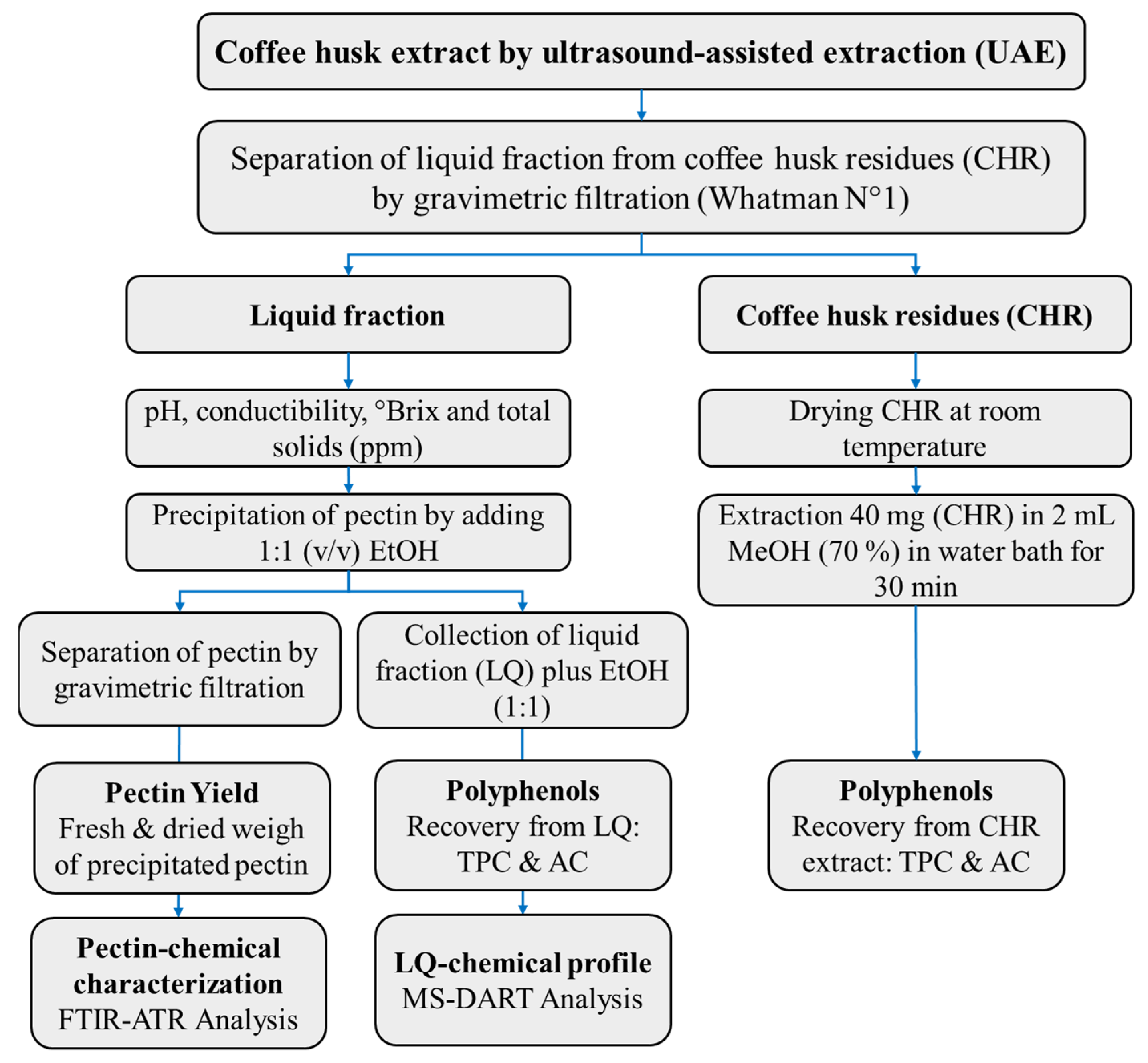

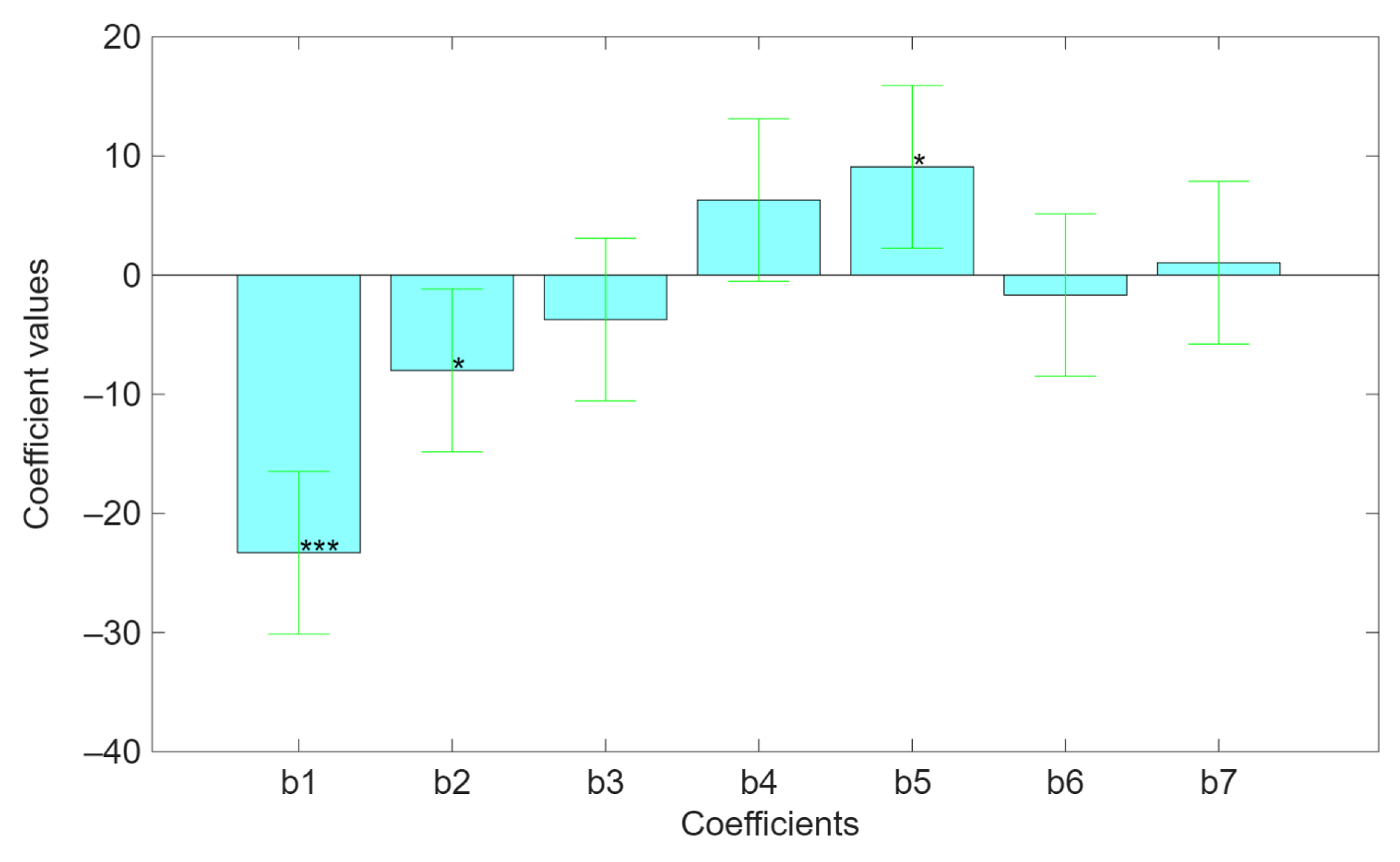

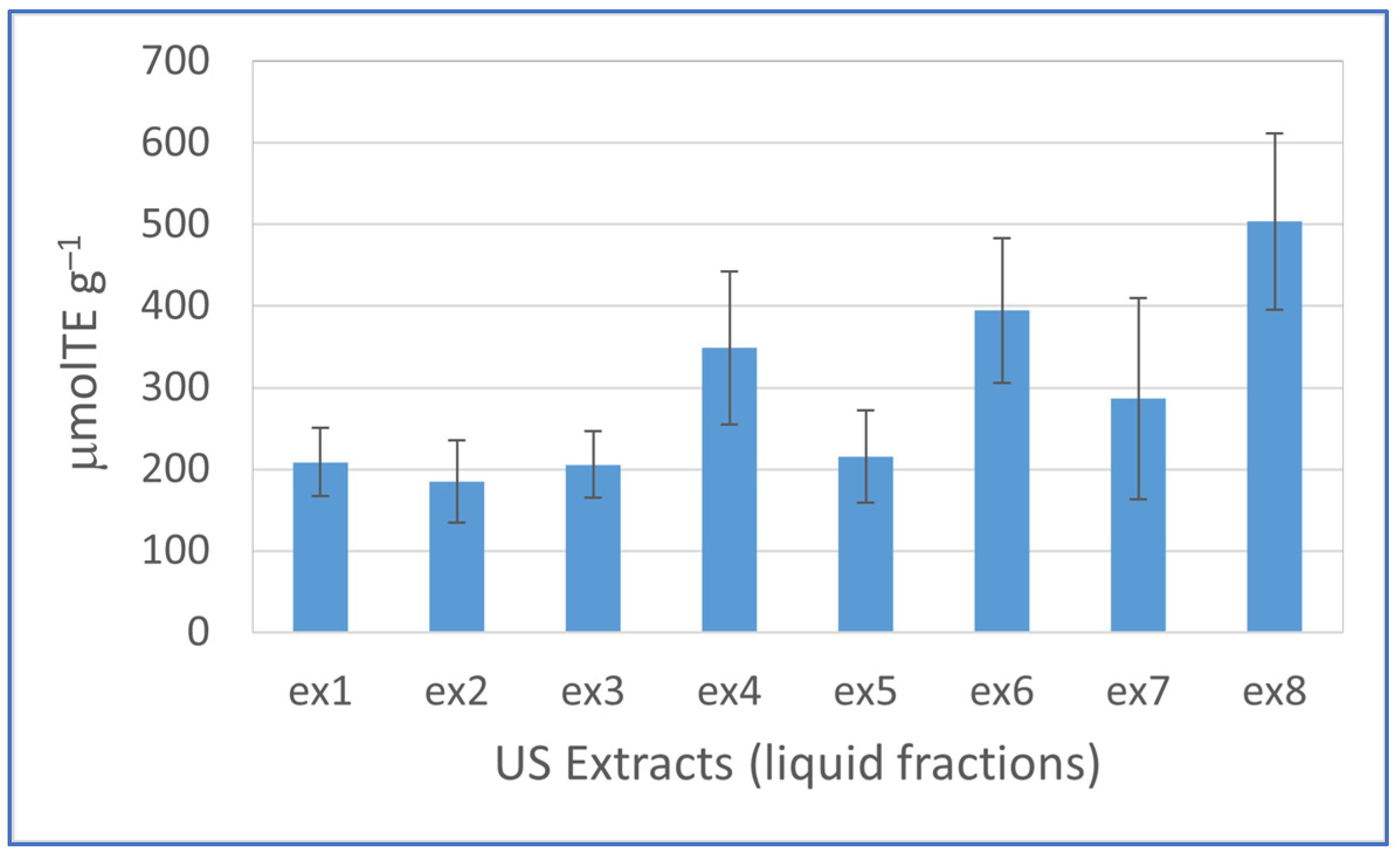

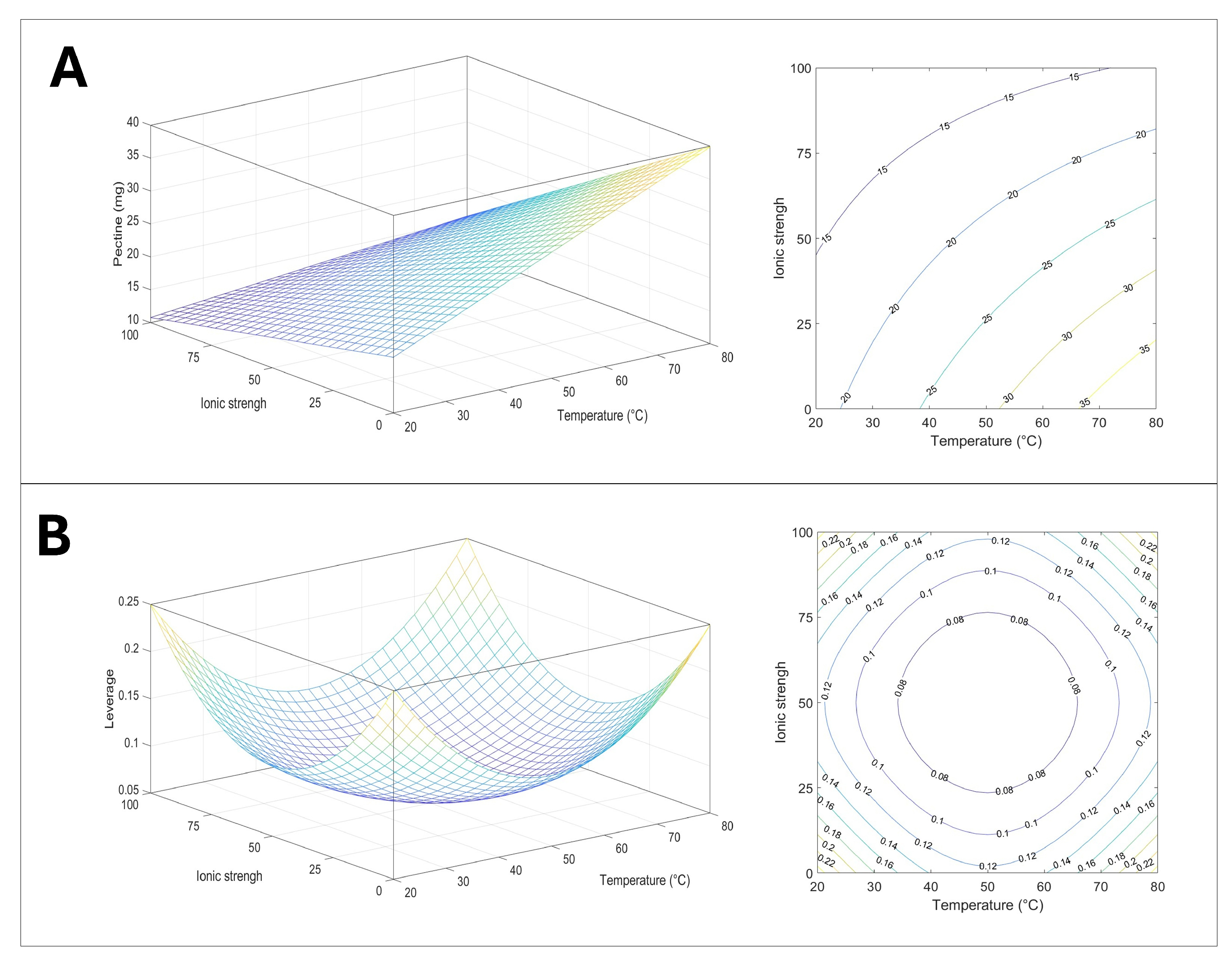
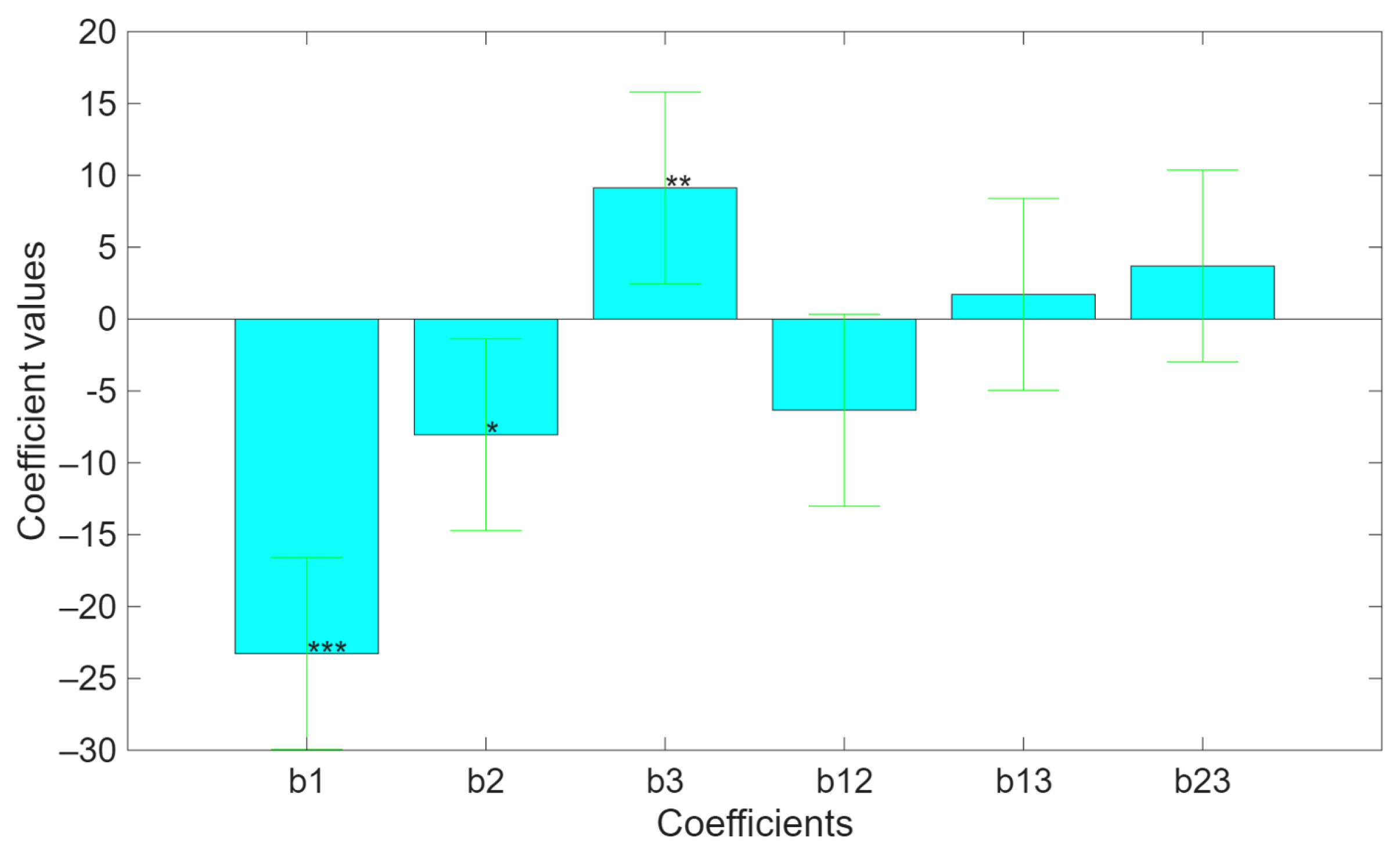

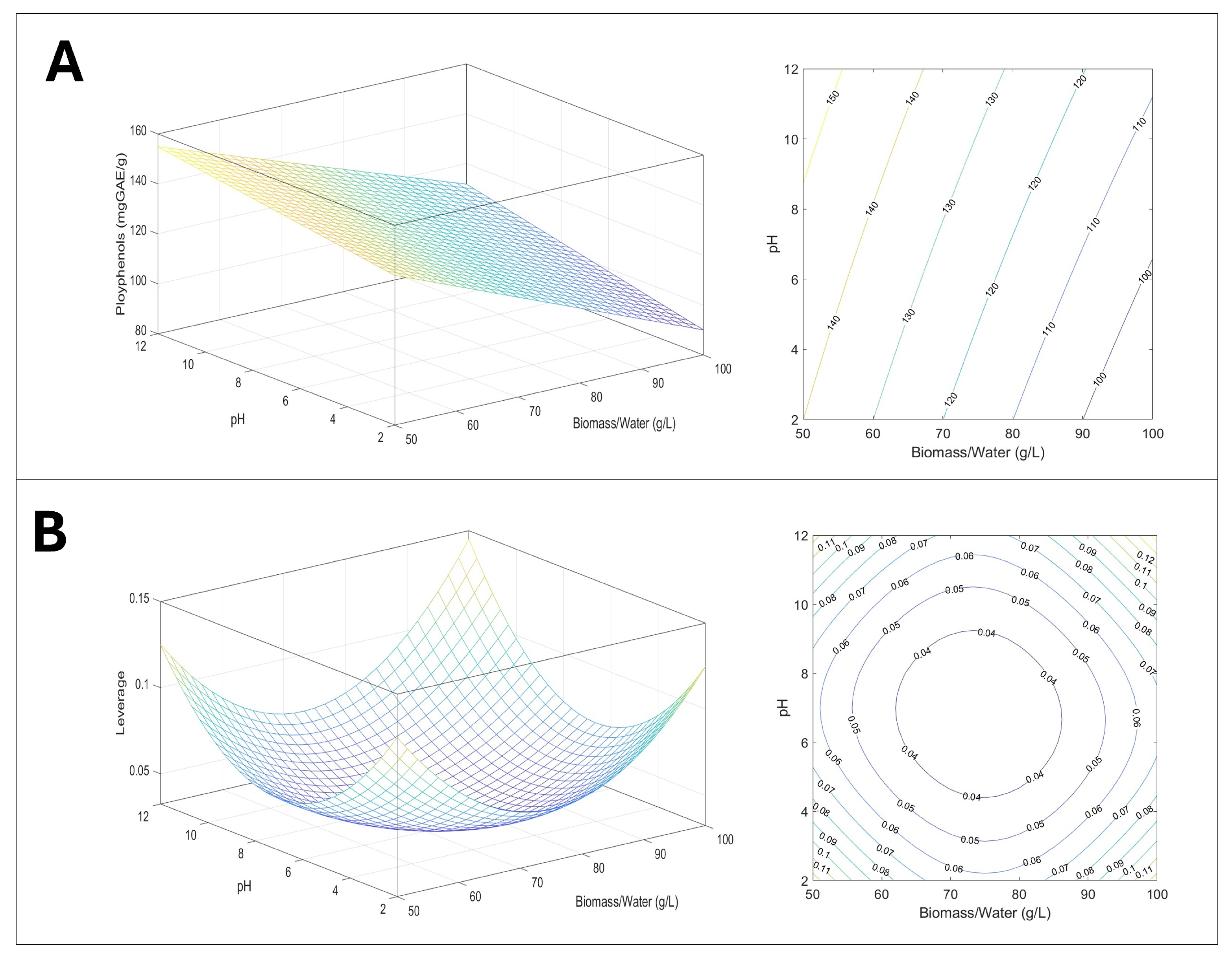
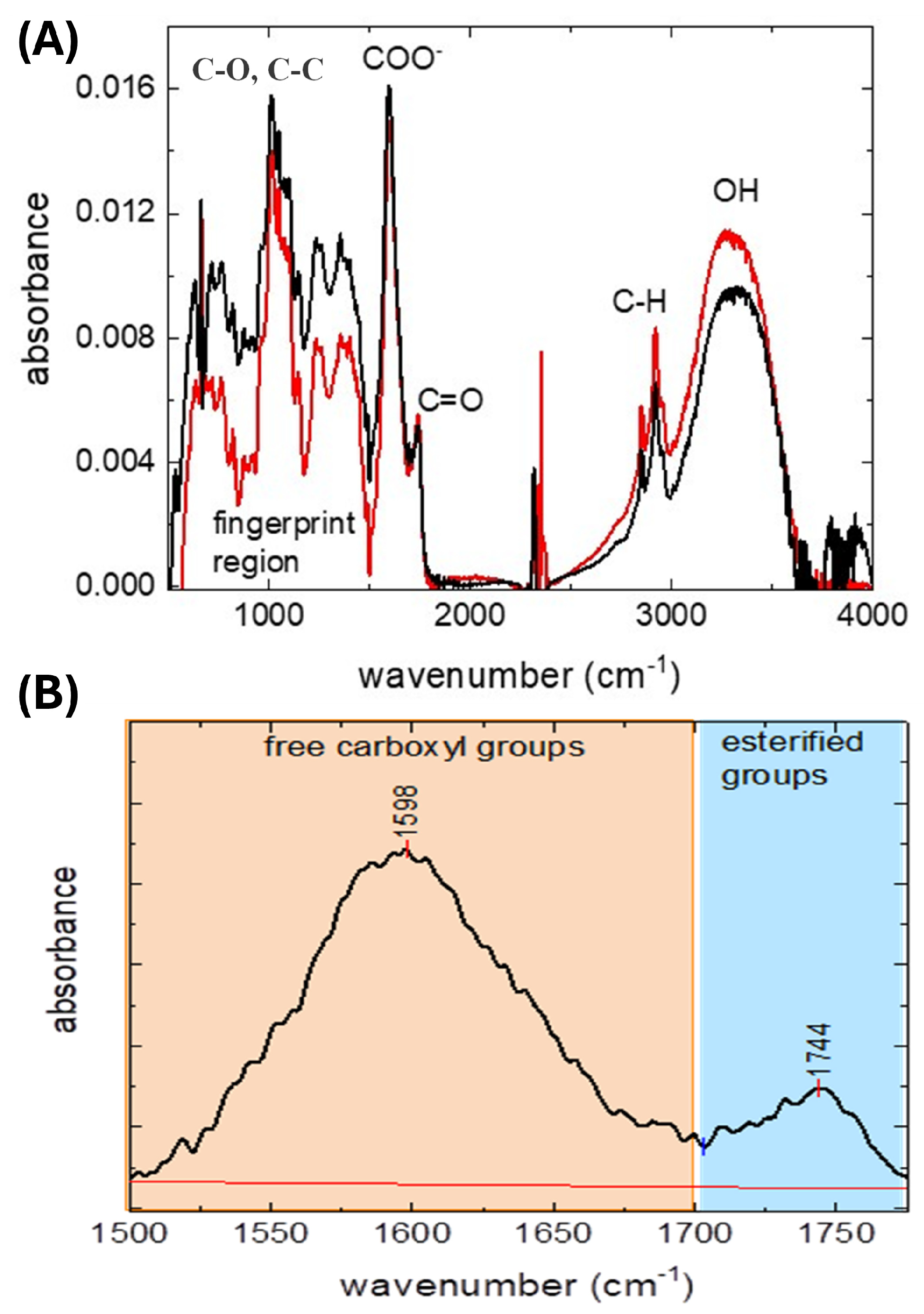
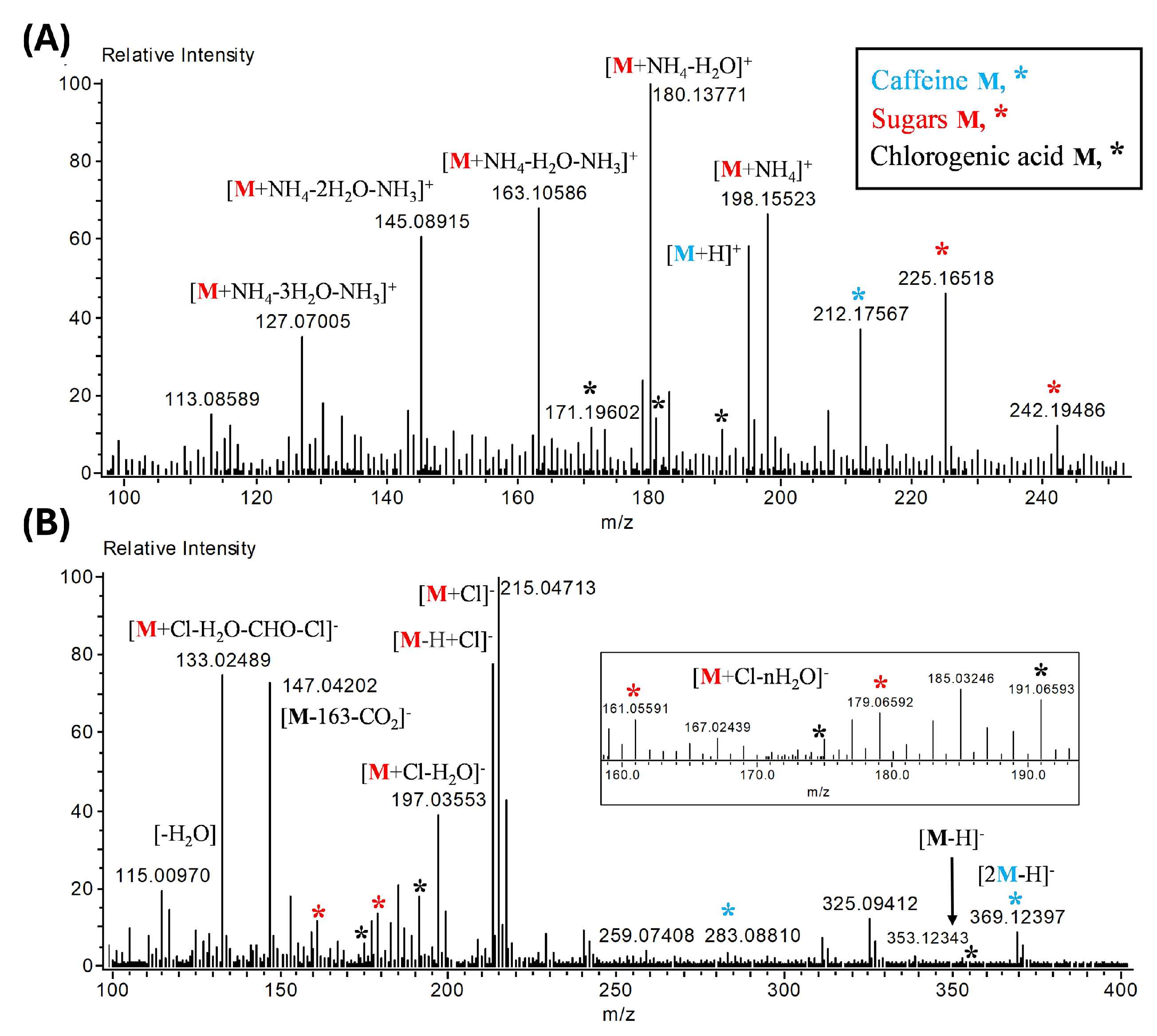
| Independent Variables | Responses | ||||||||||
|---|---|---|---|---|---|---|---|---|---|---|---|
| Run | S/L Ratio | UF | Time | Temperature | pH | Ionic Strength | Particle Sizes | Fresh Pectin | Crude Pectin | Yield Pectin | TPC |
| (X1, w/v) | (X2, kHz) | (X3, Hours) | (X4, °C) | X5 | (X6, mM NaCl) | (X7, mm or µm) | (FW, g g−1) | (DW, mg g−1) | (%) | (mgGAE g−1) | |
| ex1 | 01:10 (1) | 40 (−1) | 1 (−1) | 80 (1) | 2 (−1) | 100 (1) | mm (1) | 0.402 ± 0.03 d | 15.65 ± 0.98 de | 1.56 | 109.14 ± 6.42 b |
| ex2 | 01:10 (1) | 60 (1) | 1 (−1) | 20 (−1) | 12 (1) | 0.1 (−1) | mm (1) | 0.235 ± 0.03 d | 18.47 ± 2.55 d | 1.84 | 102.03 ± 2.76 b |
| ex3 | 01:10 (1) | 60 (1) | 3 (1) | 20 (−1) | 2 (−1) | 100 (1) | µm (−1) | 0.308 ± 0.02 d | 11.15 ± 0.90 de | 1.11 | 70.95 ± 5.15 c |
| ex4 | 01:20 (−1) | 60 (1) | 3 (1) | 80 (1) | 2 (−1) | 0.1 (−1) | mm (1) | 1.525 ± 0.06 a | 39.90± 0.18 a | 3.99 | 135.61 ± 17.55 ab |
| ex5 | 01:10 (1) | 40 (−1) | 3 (1) | 80 (1) | 12 (1) | 0.1 (−1) | µm (−1) | 1.269 ± 0.23 ab | 37.55 ± 4.60 ab | 3.75 | 121.12 ± 17.7 ab |
| ex6 | 01:20 (−1) | 60 (1) | 1 (−1) | 80 (1) | 12 (1) | 100 (1) | µm (−1) | 0.741 ± 0.06 c | 28.22 ± 1.78 c | 2.82 | 155.81 ± 6.62 a |
| ex7 | 01:20 (−1) | 40 (−1) | 3 (1) | 20 (−1) | 12 (1) | 100 (1) | mm (1) | 0.252 ± 0.03 d | 10.77 ± 1.12 e | 1.07 | 153.82 ± 5.98 a |
| ex8 | 01:20 (−1) | 40 (−1) | 1 (−1) | 20 (−1) | 2 (−1) | 0.1 (−1) | µm (−1) | 0.993 ± 0.05 bc | 30.10 ± 1.81 bc | 3.01 | 144.41 ± 4.65 ab |
Disclaimer/Publisher’s Note: The statements, opinions and data contained in all publications are solely those of the individual author(s) and contributor(s) and not of MDPI and/or the editor(s). MDPI and/or the editor(s) disclaim responsibility for any injury to people or property resulting from any ideas, methods, instructions or products referred to in the content. |
© 2025 by the authors. Licensee MDPI, Basel, Switzerland. This article is an open access article distributed under the terms and conditions of the Creative Commons Attribution (CC BY) license (https://creativecommons.org/licenses/by/4.0/).
Share and Cite
Emanuel, B.-Q.; Oliviero, M.; Fabio, Z.; Silvia, P.; Serena, G.; Loretta, B. Modeling and Optimizing Ultrasound-Assisted Extractions of Pectin and Phenolic Compounds from Coffee Husk Waste Using Response Surface Methodology. Biomass 2025, 5, 53. https://doi.org/10.3390/biomass5030053
Emanuel B-Q, Oliviero M, Fabio Z, Silvia P, Serena G, Loretta B. Modeling and Optimizing Ultrasound-Assisted Extractions of Pectin and Phenolic Compounds from Coffee Husk Waste Using Response Surface Methodology. Biomass. 2025; 5(3):53. https://doi.org/10.3390/biomass5030053
Chicago/Turabian StyleEmanuel, Bojórquez-Quintal, Maccioni Oliviero, Zaza Fabio, Procacci Silvia, Gagliardi Serena, and Bacchetta Loretta. 2025. "Modeling and Optimizing Ultrasound-Assisted Extractions of Pectin and Phenolic Compounds from Coffee Husk Waste Using Response Surface Methodology" Biomass 5, no. 3: 53. https://doi.org/10.3390/biomass5030053
APA StyleEmanuel, B.-Q., Oliviero, M., Fabio, Z., Silvia, P., Serena, G., & Loretta, B. (2025). Modeling and Optimizing Ultrasound-Assisted Extractions of Pectin and Phenolic Compounds from Coffee Husk Waste Using Response Surface Methodology. Biomass, 5(3), 53. https://doi.org/10.3390/biomass5030053







